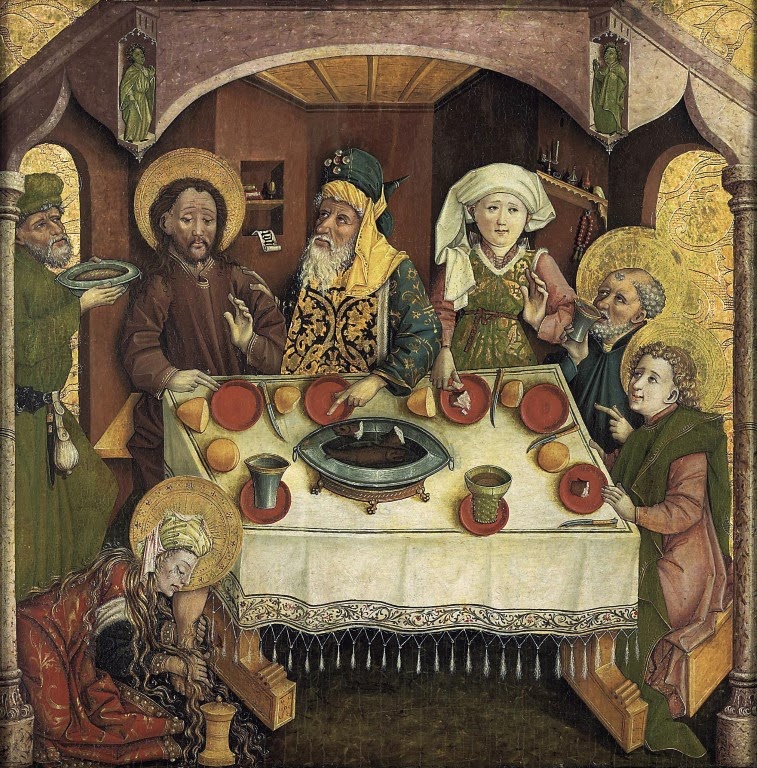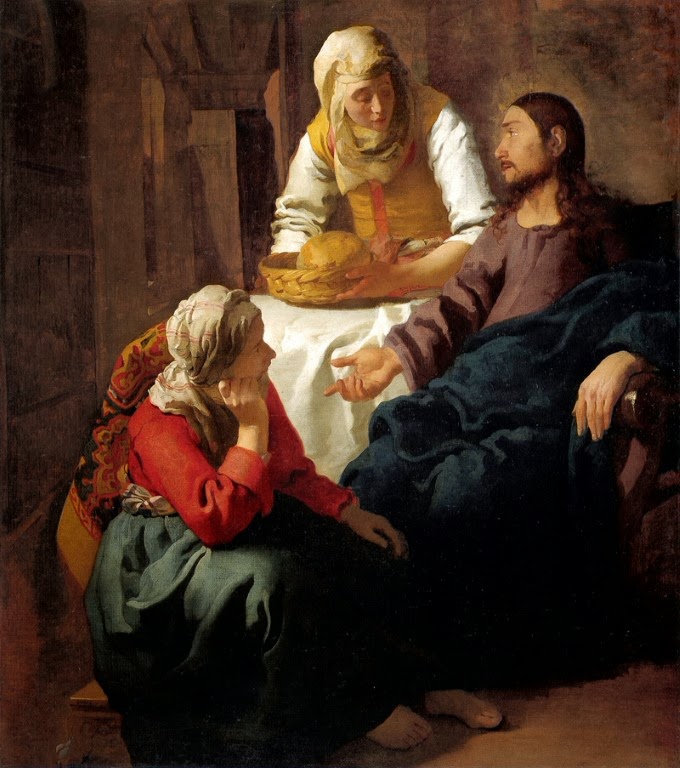How much do you know about the anointing of Christ? Do you know about the leprous Pharisee? For that matter, did you know that there were actually two anointings? There were. The first one occurred early on in Jesus’ ministry, while the second took place in the week leading up to Good Friday. It appears that the same people are involved: Mary of Cusa (who is almost certainly Mary Magdalene, as we will see) anoints Jesus in the house of a Pharisee named Simon.
But the details of the two events are very different, and the Gospel of John makes it clear that these are two different events: it describes the second anointing in some detail in John 12:1-8, but refers, in John 11:2, to Mary having previously anointed Him.
The first of the two anointings is alluded to briefly in John 11:2, and described in detail in Luke 7. It appears to have happened relatively early in Jesus’ ministry. Luke tells it in the context of the naysaying about Christ. In v. 34, Jesus laments that the Pharisees and others were saying of Him: “Behold, a glutton and a drunkard, a friend of tax collectors and sinners!” (Lk. 7:34). As if to demonstrate the point, Luke then tells us about an encounter in the house of Simon the Pharisee (Luke 7:36-50):
Moretto Da Brescia,
Supper in the House of Simon Pharisee (1453)One of the Pharisees asked him to eat with him, and he went into the Pharisee’s house, and sat at table. And behold, a woman of the city, who was a sinner, when she learned that he was sitting at table in the Pharisee’s house, brought an alabaster flask of ointment, and standing behind him at his feet, weeping, she began to wet his feet with her tears, and wiped them with the hair of her head, and kissed his feet, and anointed them with the ointment.
Now when the Pharisee who had invited him saw it, he said to himself, “If this man were a prophet, he would have known who and what sort of woman this is who is touching him, for she is a sinner.”
And Jesus answering said to him, “Simon, I have something to say to you.” And he answered, “What is it, Teacher?” “A certain creditor had two debtors; one owed five hundred denarii, and the other fifty. When they could not pay, he forgave them both. Now which of them will love him more?” Simon answered, “The one, I suppose, to whom he forgave more.” And he said to him, “You have judged rightly.” Then turning toward the woman he said to Simon, “Do you see this woman? I entered your house, you gave me no water for my feet, but she has wet my feet with her tears and wiped them with her hair. You gave me no kiss, but from the time I came in she has not ceased to kiss my feet. You did not anoint my head with oil, but she has anointed my feet with ointment. Therefore I tell you, her sins, which are many, are forgiven, for she loved much; but he who is forgiven little, loves little.”
And he said to her, “Your sins are forgiven.” Then those who were at table with him began to say among themselves, “Who is this, who even forgives sins?” And he said to the woman, “Your faith has saved you; go in peace.”
Luke doesn’t name the sinful woman in question, but mentions immediately after this that Mary Magdalene began following Christ (Lk. 8:1-3):
Soon afterward he went on through cities and villages, preaching and bringing the good news of the kingdom of God. And the twelve were with him, and also some women who had been healed of evil spirits and infirmities: Mary, called Mag′dalene, from whom seven demons had gone out, and Jo-an′na, the wife of Chu′za, Herod’s steward, and Susanna, and many others, who provided for them out of their means.
John, writing later, outright says it: “It was Mary who anointed the Lord with ointment and wiped his feet with her hair, whose brother Laz′arus was ill.”
Mary is hardly the only one to follow Christ after being healed. I’m reminded of a line from Mark’s Gospel, in the healing of blind Bartemaeus (Mark 10:52): “And Jesus said to him, ‘Go your way; your faith has made you well.’ And immediately he received his sight and followed him on the way.” Jesus sent the man on his way; the man recognized that his way was with Jesus. Mary Magdalene seems to have done likewise.
 |
| James Tissot, The Meal in the House of the Pharisee (1890) |
Recall that the first time, no one complained aloud. Rather, Simon simply thought ill of Mary, and of Jesus’ abilities as a prophet for letting that sort of woman touch His feet. This time, the internal grumbling isn’t coming from Simon. Mark tells us only that some at the table were complaining to themselves; Matthew says that the disciples were indignant; and John tells us that it was Judas who actually spoke out against the anointing (Jn. 12:4).
“Let her alone; why do you trouble her? She has done a beautiful thing to me. For you always have the poor with you, and whenever you will, you can do good to them; but you will not always have me. She has done what she could; she has anointed my body beforehand for burying. And truly, I say to you, wherever the gospel is preached in the whole world, what she has done will be told in memory of her.”
 |
| Christ in the House of Simon (c. 1470) |
Luke specifies that the first anointing took place in the house of Simon (Lk. 7:40). Matthew and Mark specify that the second anointing also took place in his house, but add a significant detail. Luke had described Simon simply as “one of the Pharisees” (Lk. 7:36). Matthew and Mark both refer to him as “Simon the leper” (Mt. 26:6; Mark 14:3). That’s an explosive detail.
 |
| Jan Vermeer van Delft, Christ in the House of Martha and Mary (17th c.) |
Mary Magdalene embodies the Christian’s response of tremendous love. Just consider the transition between the two anointings. The first time around, she uses a flask of ointment, and assumes a penitent posture, “standing behind him at his feet, weeping.” She doesn’t even face Him. The second time, she not only faces Him, she even anoints His Sacred Head (Mt. 26:7; Mk. 14:3).


how did St. Mary Magdalene become wealthy enough to fund the 13 ? was she an astute business woman who was considered a sinner by those jealous of her wealth? I doubt Jesus would have had her in his company if she was actively, frequently, publically, conducting um… business as a …. you know….She is a Saint.
Also, I think that Simon may have been reluctant to fully embrace our Lord because of the social pressure he felt. Mary not so much. Which does tell us that the things of this world (stature) is deadly if we let it be..
Nice post, like always
Teomatteo,
During the time that she was following Christ, she was clearly repentant of whatever her past sins are (and the Gospels are actually silent on what those sins were). I don’t think it would be shocking if she’d acquired at least some of her wealth in an unsavory way (like Zacchaeus, in Luke 19:1-10). If that is the case, this was a beautiful way of returning that wealth. But ultimately, we can only speculate on these points.
Of course, she could also have simply been from a wealthy family. Some have speculated that she was even related to Simon (his daughter, perhaps), since her sister Martha is the one serving, and her brother Lazarus is mentioned as being at the meal (John 12:2). If they weren’t related to Simon, they might well have inherited wealth: when Jesus goes to visit Mary and Martha, Luke describes the home as Martha’s house (Luke 10:38), and there’s no reference to either woman being married. So we have hints, but little more than that.
I.X.,
Joe
She was from a wealthy family, and had attended the court of herod as a young woman before her conversion,
Tremendous explanation of this, as so often this is one of the things those looking for possible Bible contradictions love to use. But the two events really were separate, and yet fit together perfectly. I wonder if Simon knew, the second time, that Jesus would be using his house for this again? If so it was perhaps a way of making up for his poor behavior the first time around? Jesus often tends to let us make up for things we have done by fixing them in our own back yard. Just another tidbit I gained from this. Beautiful!